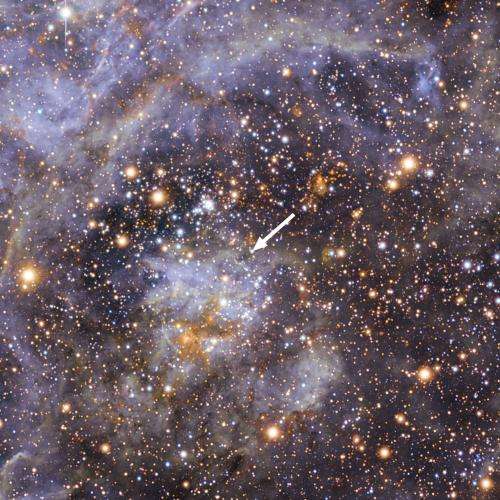VLT finds fastest rotating star

(PhysOrg.com) -- ESO's Very Large Telescope has picked up the fastest rotating star found so far. This massive bright young star lies in our neighbouring galaxy, the Large Magellanic Cloud, about 160 000 light-years from Earth. Astronomers think that it may have had a violent past and has been ejected from a double star system by its exploding companion.
An international team of astronomers has been using ESO's Very Large Telescope at the Paranal Observatory in Chile, to make a survey of the heaviest and brightest stars in the Tarantula Nebula, in the Large Magellanic Cloud. Among the many brilliant stars in this stellar nursery the team has spotted one, called VFTS 102, that is rotating at more than two million kilometres per hour — more than three hundred times faster than the Sun and very close to the point at which it would be torn apart due to centrifugal forces. VFTS 102 is the fastest rotating star known to date.
The astronomers also found that the star, which is around 25 times the mass of the Sun and about one hundred thousand times brighter, was moving through space at a significantly different speed from its neighbours.
"The remarkable rotation speed and the unusual motion compared to the surrounding stars led us to wonder if this star had had an unusual early life. We were suspicious." explains Philip Dufton (Queen's University Belfast, Northern Ireland, UK), lead author of the paper presenting the results.

This difference in speed could imply that VFTS 102 is a runaway star -- a star that has been ejected from a double star system after its companion exploded as a supernova. This idea is supported by two further clues: a pulsar and an associated supernova remnant in its vicinity.
The team has developed a possible back story for this very unusual star. It could have started life as one component of a binary star system. If the two stars were close, gas from the companion could have streamed over and in the process the star would have spun faster and faster. This would explain one unusual fact — why it is rotating so fast. After a short lifetime of about ten million years, the massive companion would have exploded as a supernova — which could explain the characteristic gas cloud known as a supernova remnant found nearby. The explosion would also have led to the ejection of the star and could explain the third anomaly — the difference between its speed and that of other stars in the region. As it collapsed, the massive companion would have turned into the pulsar that is observed today, and which completes the solution to the puzzle.
Although the astronomers cannot yet be sure that this is exactly what happened, Dufton concludes "This is a compelling story because it explains each of the unusual features that we've seen. This star is certainly showing us unexpected sides of the short, but dramatic lives of the heaviest stars."
Provided by ESO



















